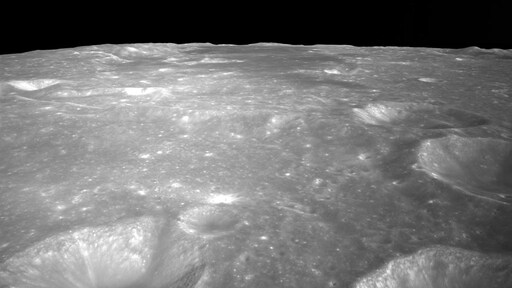The Chinese spacecraft that will carry rocks from the far side of the moon to Earth for the first time began its return journey last night. Experts are excited, but they also fear that the moon will become a scene of conflicts between countries over raw materials. Six questions and answers.
1. What was China looking for on the far side of the moon?
Stones. The Change’e-6 spacecraft landed last Sunday. Landing there is more difficult than landing on the front, because flight control has no direct contact with the ships as they fly behind the Moon. China has collected about two kilograms of rocks there. It is now on its way back to Earth, where scientists will examine those rocks.
2. Did they go for knowledge or also for prestige?
“Both,” says astronomer Lukas Ellerbrock. “Officially, these missions are for science. This was already the case with previous Apollo missions. The first thing Neil Armstrong and Buzz Aldrin did in 1969 when they set foot on the Moon: conduct seismic tests and place mirrors to detect laser beams emanating from the Moon.” Earth But if there had not been a prestige battle with the Soviet Union, the Apollo program would never have been funded, because they didn’t think the Moon was that important, and they wanted to basically defeat the Soviets.
The same motivations are now at play, Ellerbrock says. China wants to show that it is not inferior to America technologically. “But at the same time, the mission is quite a scientific project.”
He stresses that Ellerbrock has “deeply mixed feelings” about the science. “I am of course very excited about the new knowledge. But I am also concerned about the commercial interests of all kinds of parties. Especially the prospect of all kinds of countries extracting minerals on their own.”
3. What else do we want to know about the Moon?
Lunar researcher Wim van Vesterenen, professor of planetary evolution at Vrije Universiteit Amsterdam, explains it this way: “You can say we live on Earth, but it might be better to say we live in an Earth-Moon system. They have been together for 4.5 billion years, “The Moon is smaller and cools faster, there is no weather, much less gravity, and no atmosphere, so the early features of the Earth are frozen there. We can learn a lot about the origins of the Moon.”
The most important question, says Ellerbrock: How exactly was the Moon formed? “We believe that a small planet collided with the Earth and that the Moon was formed from the debris of that planet and part of the Earth’s crust. The Moon is very important for life on Earth. Thanks to the Moon, the Earth rotates more slowly and the Moon’s axis also ensures that the Earth does not rotate, ensuring stability during seasonal transitions. The Earth would have “More fluctuating and the climate and seasons seemed very different, more extreme, shedding more light on the question under what conditions life is possible on planets.”
4. There are also stones in the front, what’s special about the back?
“The stones are a kind of history book,” Ellerbrock says. “The Chinese mission was not only at the back, but near the South Pole as well. It has always been colder at the South Pole than at the front. The sun never shines there. There is evidence of water in that area, in the form of ice. There may be A wealth of information there.”
Wim van Vesterenen says he hopes craters at the South Pole will reveal a different type of rock than other parts of the moon. “On the far side of the moon there is a huge impact crater near the south pole,” he explains. “This is the deepest hole on the Moon. Scientists hope to find different rocks here than in the foreground. We hope to find rocks from the mantle, which is the layer beneath the crust. On Earth we can’t get that deep, but maybe we can find Stones from this layer are in that hole on the moon.”
There are already approximately 400 kilograms of moon rocks on Earth, but all of those samples were collected in the foreground.
Moon researcher Van Westerinen also hopes to conduct research on the stones that are now on their way to China. “I happen to have just returned from China because I work with Chinese scientists. During the previous mission with Chang’e-5, rocks were also collected. Two years later, those rocks have become available to scientists from other countries. I expect them to do the same with these stones.” And yes, I hope to get a piece to research for myself.
Van Vesterenen says this discovery may also be disappointing. The crater is the result of an impact, which may have reached extremely high temperatures. “It is possible that only molten rock was found that was no longer recognizable in its original form. That would be a great shame.”
5. In short: What about this dark side?
The Moon always faces the Earth with the same side. The Moon revolves around the Earth in 29.5 days. At the same time, the man rotates one circle around his axis. “Compare it with two people holding each other while dancing, facing each other. You pivot, your partner pivots, but you never see the back of your partner’s head,” Ellerbrock says.
By the way, the dark side is not always dark: sunlight falls on it. So the “dark” side is actually the “invisible” side, or “back” of the Moon from Earth.
6. What is the future of traveling to the moon?
Ellerbrock says it will still be busy there: for science, for tourism, and perhaps also (but hopefully not) for reasons of greed. “First, you have the scientific missions. Some of them will go to the back, just as they do now. In addition, you will have the tourist flights. The technology for traveling to the Moon is now being developed by all kinds of parties, and the demand for recreational flights will automatically follow.”
Then the moon will also be developed as a “stopping place for people,” Ellerbrock says. “Probably within ten years we will see the first bases created for space travel deeper into space. The Moon could easily be used as an intermediate station, because the gravity there is one-sixth the gravity on Earth. So you need much less fuel to escape that gravity.”
For this reason, the (frozen) water supply at the Moon’s south pole is also interesting, he says: “Hydrogen could be used as propellant fuel. And perhaps also as drinking water for people.”
Van Westerenen also sees such bases in the future: “There are a large number of bases in the pipeline. The Chinese want to send humans to the moon in 2030. The Americans are also working on it through their Artemis program. They want it, just like them.” Space station, build a base where people can stay longer.”
Destruction and conflict
Ellerbrock fears that mining for land-based consumption will eventually get out of control. “There are indications that minerals can be extracted that we can use in computer chips, for example. And if billions are to be made, you know what happens. I fear that the Moon will be used for mining and that, as on Earth, this will lead to devastation.” And the conflict, and we hope that we can conclude agreements on this matter on Earth that all countries will adhere to, so let us protect the moon from greed and not plunder it.”





